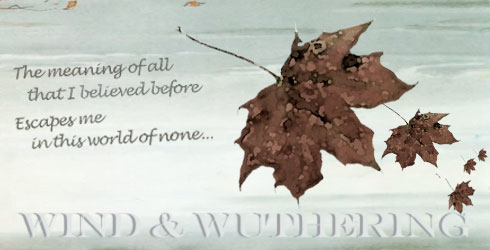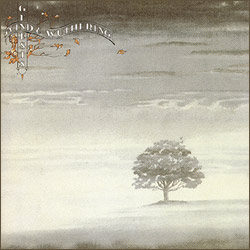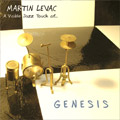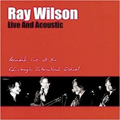


The 70s were the golden age of big albums. In a time where music is marketed multimedially one can hardly image what a compact work an album was and how important the cover design was. Wind & Wuthering is such an album.
Many listeners, remarkably, have said that Wind & Wuthering is their atmospheric companion for the autumn season, though they do not explain whether that is so because of the music or because of the title and the cover art that goes with it. However that may be, the album was in fact recorded in autumn, and the cover and the music go very well with each other.
Tax evasion leads to peculiar things, one of which was Wind & Wuthering. It is the first album the band recorded abroad. In September 1976 they booked into the renowned Hilvaria (Relight) Studios in The Netherlands where they would also record the album after that, And Then There Were Three. Genesis took David Hentschel with them. He had already co-produced A Trick Of The Tail and worked as a sound engineer on Nursery Cryme. This cooperation continued until 1980, which proves how well they worked as a team. The band started recording with a lot of self-confidence, for they had coped well with the departure of Peter Gabriel and put out a really strong album with A Trick Of The Tail. The self-confidence also caused problems that prompted Steve Hackett to leave the band after the tour. Everybody’s large output clashed with each other, particularly Tony’s and Steve’s; in the end they had to agree on which songs would be put on the album. Thirty years later Tony said that he felt good about Steve's input at the time, but „I think he said as much in various articles afterwards, that I was controlling it too much – and he's probably right“ [Chapter & Verse, p.192].
 Tony’s and Steve’s ambitions can be heard very clearly in places. There are many classical reminiscences on the album, to which came Phil Collins’s fusion-style drumming and the well-rounded pop compositions by Mike Rutherford. The result was an album that presents the classic line-up of four in perfection and gives us a glimpse at later releases that would focus more on songs. All in all the compositions are more compact and less playful than on A Trick Of The Tail.
Tony’s and Steve’s ambitions can be heard very clearly in places. There are many classical reminiscences on the album, to which came Phil Collins’s fusion-style drumming and the well-rounded pop compositions by Mike Rutherford. The result was an album that presents the classic line-up of four in perfection and gives us a glimpse at later releases that would focus more on songs. All in all the compositions are more compact and less playful than on A Trick Of The Tail.
The opening song Eleventh Earl Of Mar is a good illustration. After a brief instrumental overture a strong, driving beat becomes the foundation for the verse. The song has an almost conventional structure with recurring parts were it not for the lack of a proper chorus. Eleventh Earl Of Mar tells the story of the Jacobite uprising in the Highlands in 1715. It is narrated from the point of view of a child that hears the story from its father. The vocal rendition is particularly effective when you listen to the part where the (presumable) son urges the father to read on. You can almost feel the excited begging. The dream has also found a proper musical equivalent that interrupts the composition with a very calm passage. Steve’s nylon guitar takes the lead role in this part. It also reveals the full strength of the band: They have found a great way to put the story to music and create, as it were, a fantastic film for the ears.
One For The Vine keeps up the momentum. It is an epic longtrack that flows along calmly despite its complex rendition. It is a typical Banks song full of changes in harmonies, peculiar time signatures and unusual chords. Tony had chosen a peculiar sequence. The individual parts are finished completely before the next part is introduced by a brief theme on the piano or the guitar. The band dispensed with transitions, as it were, in these places. They found it rather difficult to find a proper arrangement for the song, and that is not surprising if you examine the sheet music. The mood of the song resembles Mad Man Moon from their previous album. The story, however, fits Eleventh Earl Of Mar, for here again is someone else who sends a host of people to destruction. The deeper focus of the song is on the fatal seduction of the masses. In 2008 Phil Collins said in an interview that they had the impression that not everybody did understand everything, every word in our songs, so the image was added to make the emotional character of our songs come out clearer [Frankfurter Allgemeine Zeitung, 04/06/2008]. The German print of the album actually had lyrics sheets with a translation.
The song seems like a classical piano ballad that takes a rough turn in its third part and suddenly switches to a fusion-like theme in 5/4. It is a funny idea and shows their talent for sophisticated composition and clever inventions. The most brilliant thing is the fact that they kept this song together as a harmonious unit despite this contrast and the fragmentation mentioned above.
Your Own Special Way was probably intended as a contrast for the melancholic, demanding One For The Vine. It is a comparatively light-footed catchy song, and therefore became the only single from the album. Though it did not exceedingly well it did show that this band was capable of moving into the mainstream and writing big commercial hits. Wind & Wuthering showcases the compositional style of the individual band members, and Your Own Special Way is obviously Mike’s baby. Many fans dislike the song because it songs quite bombastic. It is a song about being together, but the word love is carefully avoided. Mike wrapped it all up in a lyrical text rich with metaphors. Despite the musical preferences one has to admit the song has qualities. It is consistent, accessible and has lyrics like a poem.
If Your Own Special Way is Mike’s thing then Wot Gorilla? demonstrates Phil’s penchant for jazz rock. This one is a very lively piece of music that is ever so slightly over the top. Tony Banks, who co-wrote the song, adds some classical music to it by inserting chord changes that resembles baroque organ compositions. Despite some subliminal grumbling the band, ironically, stick to a simple 4/4 full of joy of playing. It sometimes occurs to the reviewer that the band tried to put all the vivacity of a Cinema Show live version into a studio recording.
Festive organ sounds mark the beginning of All In A Mouse’s Night, the first song on the second side of the album. The title indicates that we are told a fable. Just like Eleventh Earl Of Mar this song has, despite repeating parts, no classical song structure, but it is a well-rounded, coherent song that ends in a majestic moral. Tongue-in-cheek humour luckily saves the lyrics from embarrassing pathos. The music lives off the contrast between verse-like thin parts and rich symphonic parts. This change in dynamics provides the tension the lyrics demand with their cat-and-mouse game. Steve adds a nervous ambient sound of scratching, wafting sounds in the quiet parts. The unorthodox use of the guitar and the complete lack of rock clichés show just how important Steve was for early Genesis, and a song like Blood On The Rooftops illustrates the options the band lost when he left the band.
Classical guitar creates a lovely melancholy and leads the listener imperceptibly into the vocals. These stay close to the guitar line, melting into a perfect unity. “Day and grey, and English film, the Wednesday play.” We immerse in the scene and are taken to England. The contrast between drab reality and shiny world of American movies becomes a listening experience. Phil and Steve work together perfectly. Steve provided melancholic verses, and Phil added a big chorus to it. Many fans consider Blood On The Rooftops a highlight on Wind & Wuthering.
Unquiet Slumbers For The Sleepers continues in this vein. The brief instrumental recall the musical interludes on The Lamb Lies Down On Broadway. Steve’s floating nylon guitar and Tony’s almost whistling synth create a magic, otherworldly atmosphere. Slowly we float into the next song that is going full steam ahead. In That Quiet Earth is a lively, sometimes hectic instrumental, a bit like Duke’s Travels. In That Quiet Earth is the only song on Wind & Wuthering that was written by whole band, and it proves how competent the band have become. Each musician has his opportunity to shine without overshadowing the others. They confidently create musical tensions and make good use from the large store of compositional options. Genesis have become a mature group who know what they want. They utilize the dramatic, wild element of the song to arrive on the spot in the relaxed, almost soulful mood of Afterglow.
The effect of that was so great that they would use it live for the next ten years. Though In That Quiet Earth may be replaced be other songs (e.g. in the Old Medley) the releasing effect of Afterglow remained – it became a live classic. Tony explained that he had written it spontaneously: „I wrote [Afterglow] pretty much in the time it takes to play it, and consequently [it] has a spirit about it that comes from being less contrived.“ [Chapter & Verse, p. 177]. One will hardly find a better description for Afterglow. It hovers along weightlessly, gains substance and finally towers like a thundercloud grown from a gentle shroud of clouds. Phil proves how much he has grown as a singer, how much strength there is in his initially fragile voice. From here on, Genesis songs do not aim at the brain, but at the heart. This ever increasing and intensifying finale leaves the listener with the impression of a dignified, almost august album. If you compare Wind & Wuthering with its predecessor, A Trick Of The Tail, you will realize that this album was arranged very neatly without any frills. It is less romantic, less gentle than its predecessor, but it makes up for it with power and a sense of adventure. Genesis still tell their stories, but they have already turned their eyes towards a brighter, more streamlined future. With the last notes of Afterglow ends a book that began with the words Looking For Someone and spanned seven years full of glorious tales.
By Robert Krauskopf
English by Martin Klinkhardt



Brand new album by Martin Levac. Contains eleven Genesis-classics in Jazz style.



Live-Unplugged-Album from 2001 with lots of Genesis-Songs and Rock-Classics.